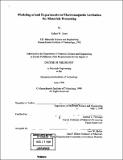| dc.contributor.advisor | Merton C. Flemings. | en_US |
| dc.contributor.author | Hyers, Robert W. (Robert Wyatt), 1971- | en_US |
| dc.date.accessioned | 2010-01-07T20:41:37Z | |
| dc.date.available | 2010-01-07T20:41:37Z | |
| dc.date.copyright | 1998 | en_US |
| dc.date.issued | 1998 | en_US |
| dc.identifier.uri | http://hdl.handle.net/1721.1/50457 | |
| dc.description | Thesis (Ph.D.)--Massachusetts Institute of Technology, Dept. of Materials Science and Engineering, 1998. | en_US |
| dc.description | Vita. | en_US |
| dc.description | Includes bibliographical references (p. 111-116). | en_US |
| dc.description.abstract | Electromagnetic levitation (EML) is an important experimental technique for research in materials processing. It has been applied for many years to a wide variety of research areas, including studies of nucleation and growth, phase selection, reaction kinetics, and thermophysical property measurements. However, the design of these systems has, for the most part, been empirical, and it will be shown that a more fundamental approach can provide benefits in a number of aspects, leading to a better design. The work presented here contributes to three aspects of levitation systems: modeling of electromagnetic effects, modeling of fluid flow characteristics, and experiments to measure surface tension and viscosity in microgravity. In this work, the interaction between the electromagnetic field and the sample were modeled, and experiments to measure the surface tension and viscosity of liquid metal droplets were performed. The models use a 2-D axisymmetric formulation, and use the method of mutual inductances to calculate the currents induced in the sample. The magnetic flux density was calculated from the Biot-Savart law, and the force distribution obtained. Parametric studies of the total force and induced heating on the sample were carried out, as well as a study of the influence of different parameters on the internal flows in a liquid droplet. The oscillating current frequency has an important effect on the feasible operating range of an EML system. Optimization of both heating and positioning are discussed, and the use of frequencies far from those in current use for levitation of small droplets provides improved results. The dependences of the force and induced power on current, frequency, sample conductivity, and sample size are given. A model coupling the magnetic force calculations to a commercial finite-element fluid dynamics program is used to characterize the flows in a liquid sample, including transitions in the flow pattern. The dependence of fluid flow velocity on positioning force, sample viscosity, and oscillating current frequency is presented. These models were applied to the design of thermophysical property measurements were performed in microgravity on the Space Shuttle. These experiments depend on careful control of the fluid flow in the sample, based on the MHD model presented. The measurements use the oscillating drop technique to provide very precise containerless measurement of surface tension, and the first containerless measurement of viscosity. Results are presented for surface tension and viscosity of a Pd-18Si alloy for a large range of temperature, including both the superheated and undercooled regimes, as an example of the many data taken on many materials, including zirconium, steels, and modern metallic glass forming alloys. | en_US |
| dc.description.statementofresponsibility | by Robert W. Hyers. | en_US |
| dc.format.extent | 117 p. | en_US |
| dc.language.iso | eng | en_US |
| dc.publisher | Massachusetts Institute of Technology | en_US |
| dc.rights | M.I.T. theses are protected by
copyright. They may be viewed from this source for any purpose, but
reproduction or distribution in any format is prohibited without written
permission. See provided URL for inquiries about permission. | en_US |
| dc.rights.uri | http://dspace.mit.edu/handle/1721.1/7582 | en_US |
| dc.subject | Materials Science and Engineering | en_US |
| dc.title | Modeling of and experiments on electromagnetic levitation for materials processing | en_US |
| dc.type | Thesis | en_US |
| dc.description.degree | Ph.D. | en_US |
| dc.contributor.department | Massachusetts Institute of Technology. Department of Materials Science and Engineering | en_US |
| dc.identifier.oclc | 42078198 | en_US |
